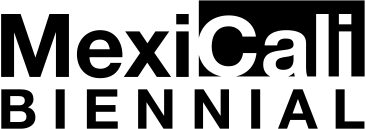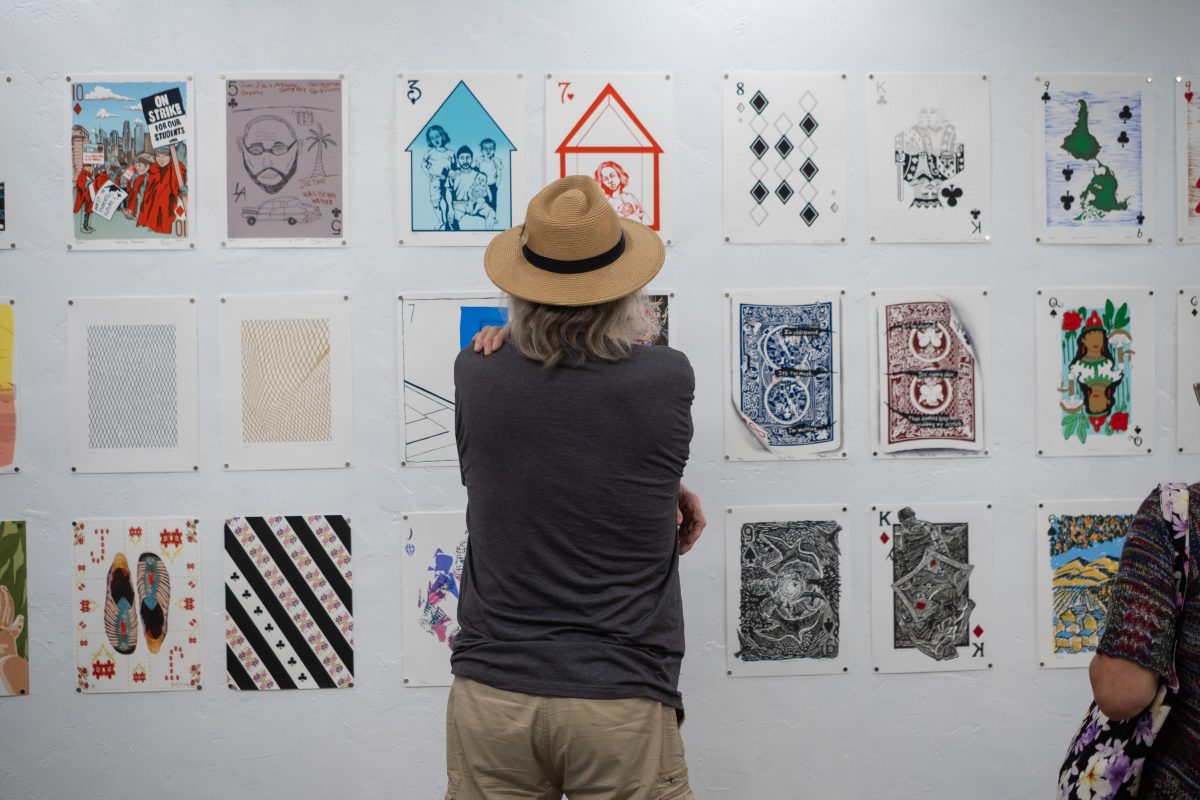The following is written by Anger is an Energy curator JV Decemvirale.
Welcome. This exhibition explores the collaborative printmaking of Whittier-based artists Miyo Stevens-Gandara and Usen Gandara. Believers in punk music’s capacity to transform anger into action, the artists have facilitated taller-style (atelier) workshops devoted to political and historical themes since 2015. Through this expanded print practice which focuses on the building of community, Miyo and Usen have earned a reputation for their indefatigable support of Los Angeles printmakers and for their commitment to the press.
Working beyond the centers of art power, these highly collaborative projects conclude with a handmade portfolio of fine art prints. Artworks in themselves, the portfolios are expensive to produce because of the quality of materials and the number of artists. To fund the portfolios, Miyo and Usen have tied together working-class Chicano (rasquache) and Japanese (mottainai もったいない) ingenuity to produce a remarkable punk catalyst for their own work and those of their colleagues. An ingenious technology, the portfolios are testaments to print’s capacity to convert anger into in-your-face graphic coercion.
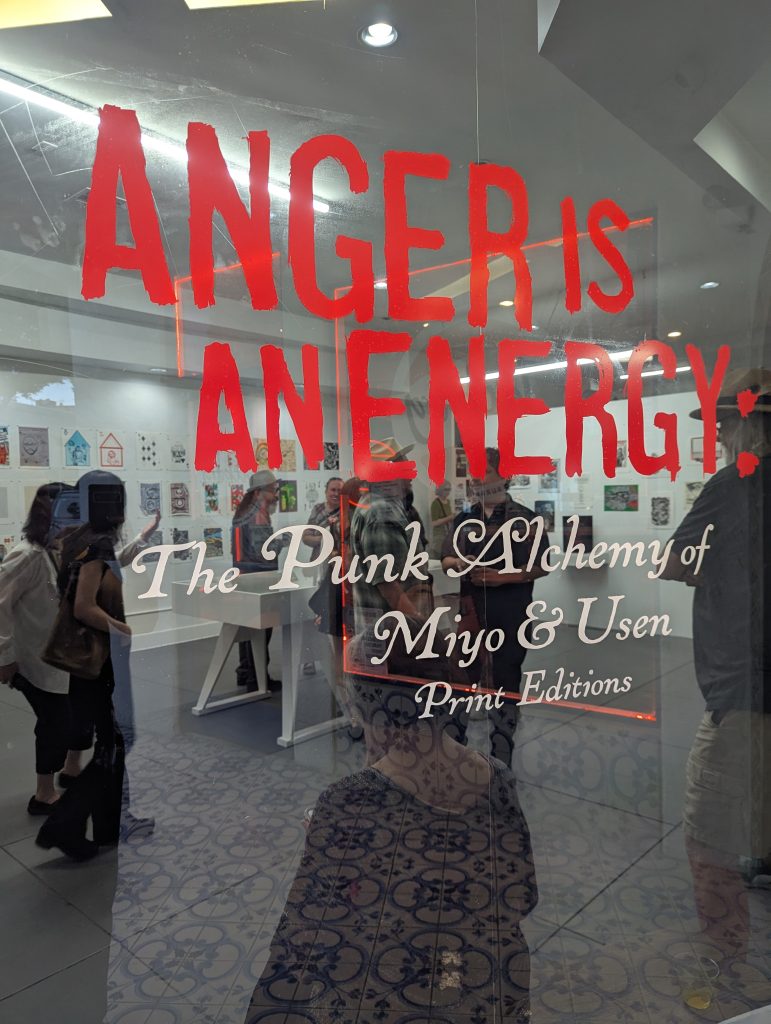
Along with a curated selection of their individual experimental prints, this will be the first time their portfolio work, LA River (2015), Utopia/Dystopia (2019), and Free Gaza (2025), are presented together. Eponymously themed, the portfolios include dozens of artists, from Puerto Rico to Indiana to East Los Angeles. This grouping of portfolios offers the public a snapshot of contemporary political printmaking, while also demonstrating how print can forge real relationships across geography. Responding to our current political landscape, these projects testify to print’s alchemical capacities to convert feelings of political helplessness and anger into artistic protest and political solidarity.
Their methods are important to analyze right now because they show us that art has a real role to play in politically chaotic times. It is our hope that the exhibition will not only resonate with the people of Whittier, but that it will also be useful to younger artists in search of replicable models for making politically-engaged art. The artworld has grown quiet as the cost for exercising free speech continues to mount. Art might not be able to fix our politics, but it does continue to give us courage to fight against the paralyzing feelings of isolation on which fascism thrives.
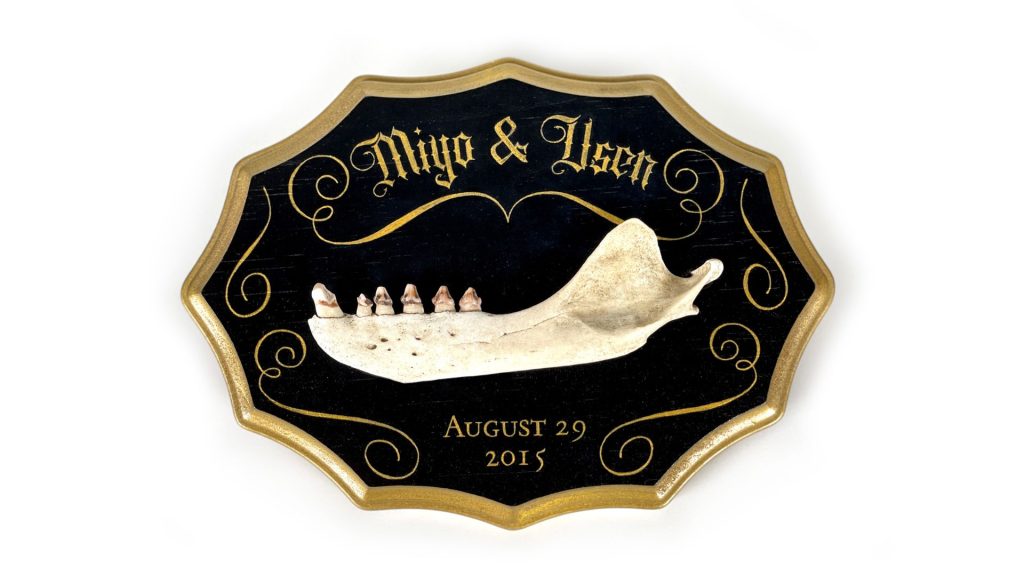
This placard [above] commemorates Miyo and Usen’s marriage and artistic partnership. First meeting as students at Schurr High School, they partnered up in 2015. Sometimes love is a jawbone you find together in the desert on your wedding day.
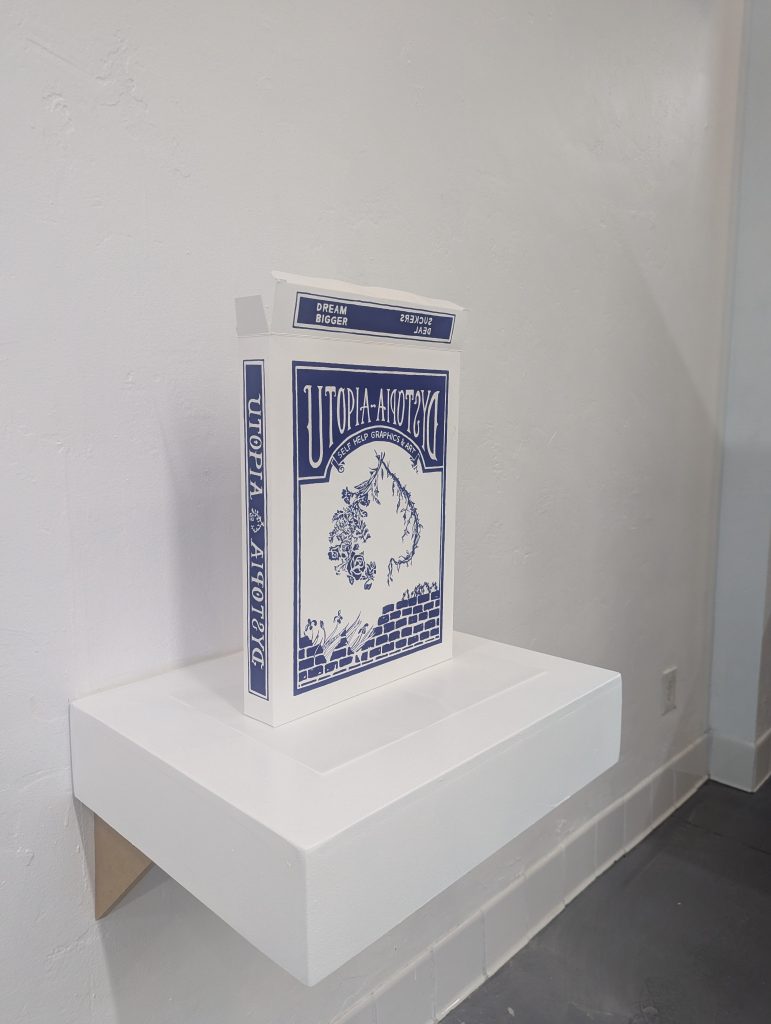
Printed during the first Trump presidency, Utopia/Dystopia is a portfolio modeled on a deck of 52 playing cards. Twenty-six artists were invited to create two cards for the deck to create their interpretation of utopia and dystopia.
The deck of cards allows the project to bring many different artists and styles together creating one unified artwork- a full deck, redefining a traditional portfolio. The concept of a deck of cards is intended to reference many things- games of chance, luck, fortune, war, solitude, precarious situations (house of cards), magic, empire, and divination. It serves as a container for many ideas, and each artist has chosen their own direction.
Portfolio box design by artist Sandra Low.
UTOPIA/DYSTOPIA collaborating artists:
Pável Acevedo, Kay Brown, Ada Pullini Brown, Leslie Dolin, Usen Gandara, Miyo Stevens-Gandara, Luis Genaro Garcia, J. Leigh Garcia, Margaret Griffith, Rogelio Gutierrez, Phung Huynh, Dongeun Lee, Kelvin Lopez, Rosalie Lopez, Sandra Low, Poli Marichal, Álvaro D. Márquez, Dalila Mendez, Wayne Perry, Sandy Rodriguez, Victor Rosas, Marianne Sadowski, Dewey Tafoya, Alex Fridrich-Ward, Christian Salcedo Ward, Andi Xoch
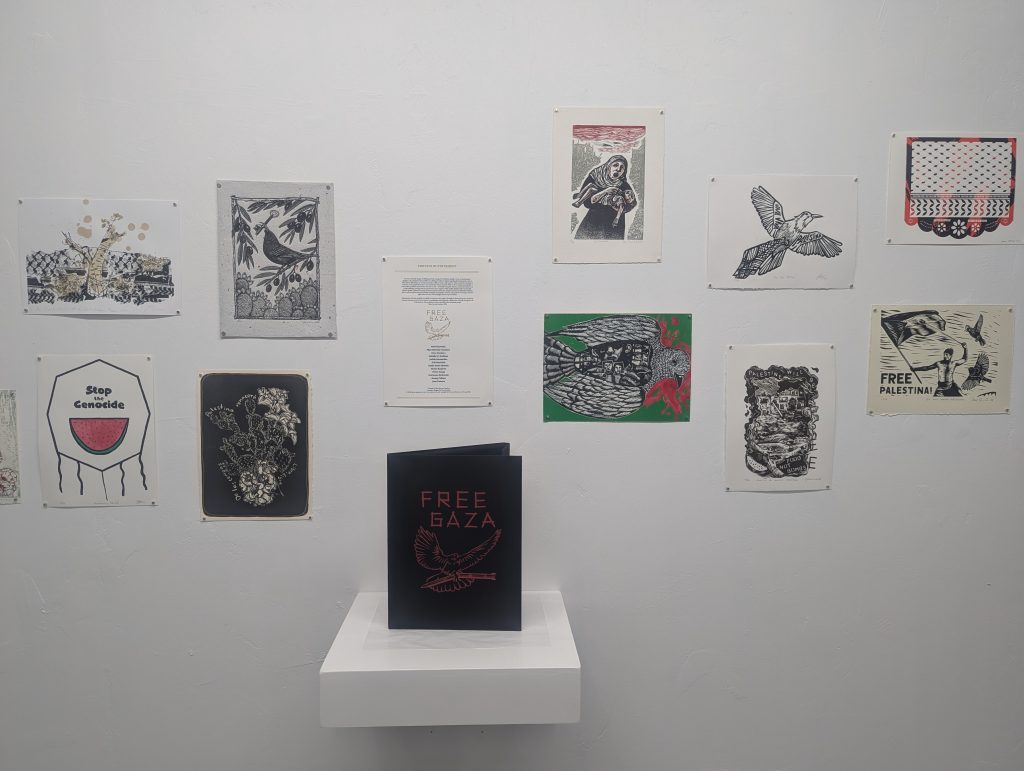
Miyo and Usen’s most recent collaboratively produced portfolio, Free Gaza (2024), is a set of twelve prints printed by twelve artists denouncing the famine and inhumane cruelty currently inflicted on the Palestinian people of Gaza. The entirety of the purchase of the portfolio goes to the United Nations Relief and Works Agency for Palestine Refugees In the Near East.
The portfolio is screen-printed with graphics by Usen Gandara.
Free Gaza (2024)
The news and daily images of suffering and loss amongst the Palestinian people in Gaza are shocking and egregious. The catalyst for this portfolio was a feeling of collective despair regarding the humanitarian crisis in Gaza and the West Bank. As an artist and mother, I felt the need to take action in order to provide some kind of assistance, to let people know that I care, and that the violence and loss of life we all are seeing is unacceptable. I noticed that my fellow artists felt the same way as I did- powerless to stop the violence, sad and devastated to see people suffering, and angry that our government was in support of this conflict despite loudly voiced public opinion against it. Many in my circle of artists produce artwork that critiques colonial and imperialist mindsets, and we cannot help but notice the familiar strategies of occupation, violence, and apartheid occurring in real time right before our eyes, in horrifyingly obvious ways in Palestine.
My intention with this portfolio is twofold; to connect artists together through the democratic power of print by creating a permanent record of our stance as a community, and to generate a small source of funds through the sale of the prints in this portfolio in order to send aid to the Palestinian people.
Miyo Stevens-Gandara, 2024
FREE GAZA collaborating artists:
Pável Acevedo, Miyo Stevens-Gandara, Usen Gandara, Natalie M. Godinez, Jackie Hernandez, Poli Marichal, Dalila Paola Mendez, Gisela Ramirez,Victor Rosas, Marianne Sadowski, Dewey Tafoya, Joan Zamora
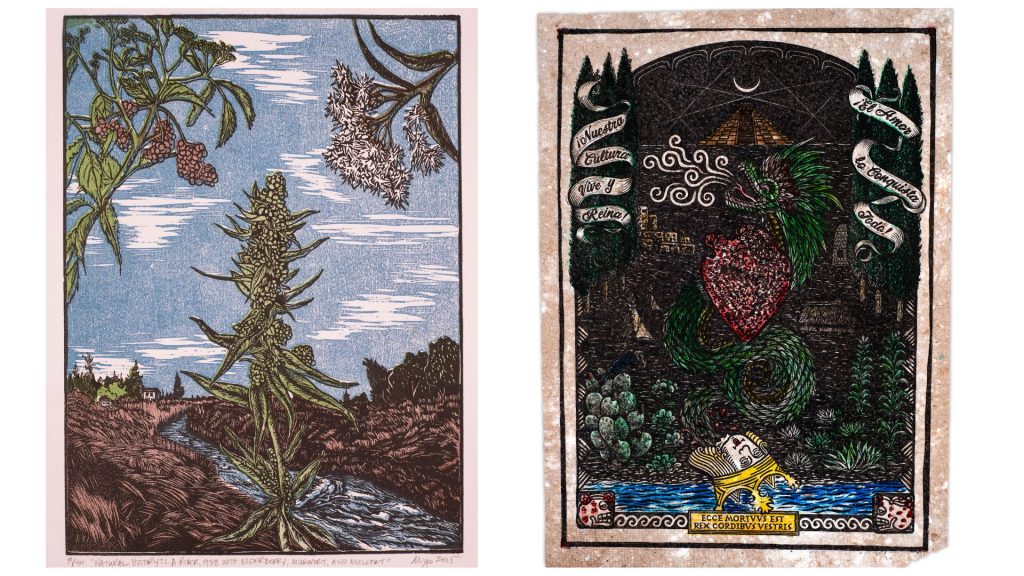
In the center vitrine is Miyo’s first portfolio project: 2015 Printmaking Survey of the Los Angeles River (2015). The artist brought together seven artists around the theme of the Los Angeles River. Invited artists frottaged river trash and became experts on the river’s developing biomes, responding with fantasy and knowledgeable testimony in equal measure.
The portfolio box was screen-printed by Alex Fridrich-Ward with graphics by Usen Gandara.
2015 Printmaking Survey of the Los Angeles River (2015)
Our collective memory of the Los Angeles River is a mixture of fact and fiction. Many of us have only a vague understanding of why the river was channelized with concrete, or no understanding at all. Television and cinema have contributed to L.A. River mythology as a place best to avoid, and many of us can reference movies or scenes shot in the river, but few know the history of what existed before the walling off of its natural banks. My brother in law summed up this sentiment when I told him we went for a walk along the river by joking, “Did you see any drag races?” As an artist I am interested in creating work that explores the history of a place, calling into question common assumptions through narrative imagery.
For this atelier I invited seven artists from different areas in Los Angeles county to contribute an image inspired by the Los Angeles River. Each artist contributed a print edition created in their own studios which show a range of approaches and processes that appropriately reflect the diversity of communities that share this important part of the landscape.
My print for this atelier was inspired by photographs taken by the U.S. Army Corps of Engineers as part of The Report on Engineering Aspects, Flood of March 1938 by the U.S. Engineer office in Los Angeles. Throughout its history the Los Angeles River has been prone to flooding, with records going back to the 19th century. The massive floods of the 1930’s motivated congress to authorize the channelization of the river, which allowed for development closer to the river’s edge.
Los Angeles River Natural History: Los Angeles River, 1938 With Elderberry, Mugwort, and Mulefat” references 18th century botanical illustrations that often feature a landscape in the background. The plants depicted are native plants of the Los Angeles river area chosen for their medicinal use by indigenous people and references to folklore.
Miyo Stevens-Gandara, 2015
L.A. RIVER participating artists:
Miyo Stevens-Gandara, Usen Gandara, Alex Fridrich-Ward, Christian Salcedo Ward, Poli Marichal, Álvaro D. Márquez, and Kimiko Miyoshi.
Anger is an Energy also features three pairings of Miyo and Usen’s work.
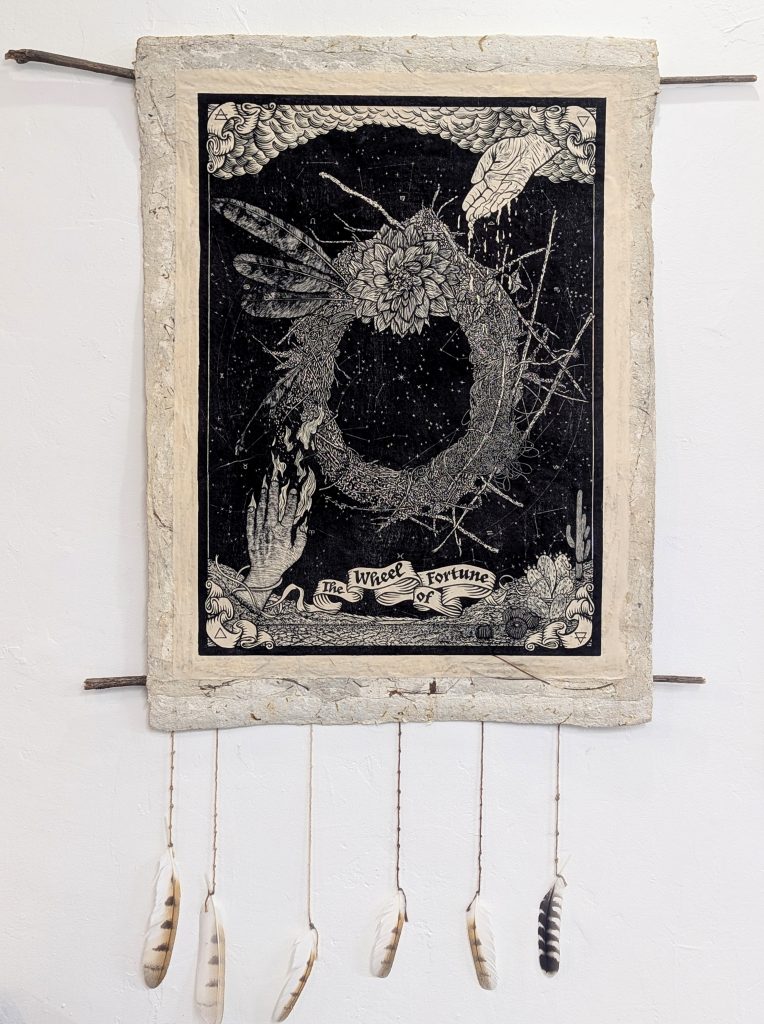
Usen’s blockprint is printed on handmade paper made from local Whittier junkmail. The hand of fire and the hand of water perpetuate the forever turning wheel of fortune. Through destruction and rebirth emerges a present represented as an empty nest with constellations in the center. Using the visual archives of alchemy and the tarot, the print taps into chance and archetypal imagery as relatable and fertile sources of human chemistry. Visualizing non-linear cycles can expand one’s interior sense of time (and space), similar to the effects of sacred geometries, which also appear across this wall. Usen often turns to Alexander Roob’s Alchemy & Mysticism (2015) as a resource.
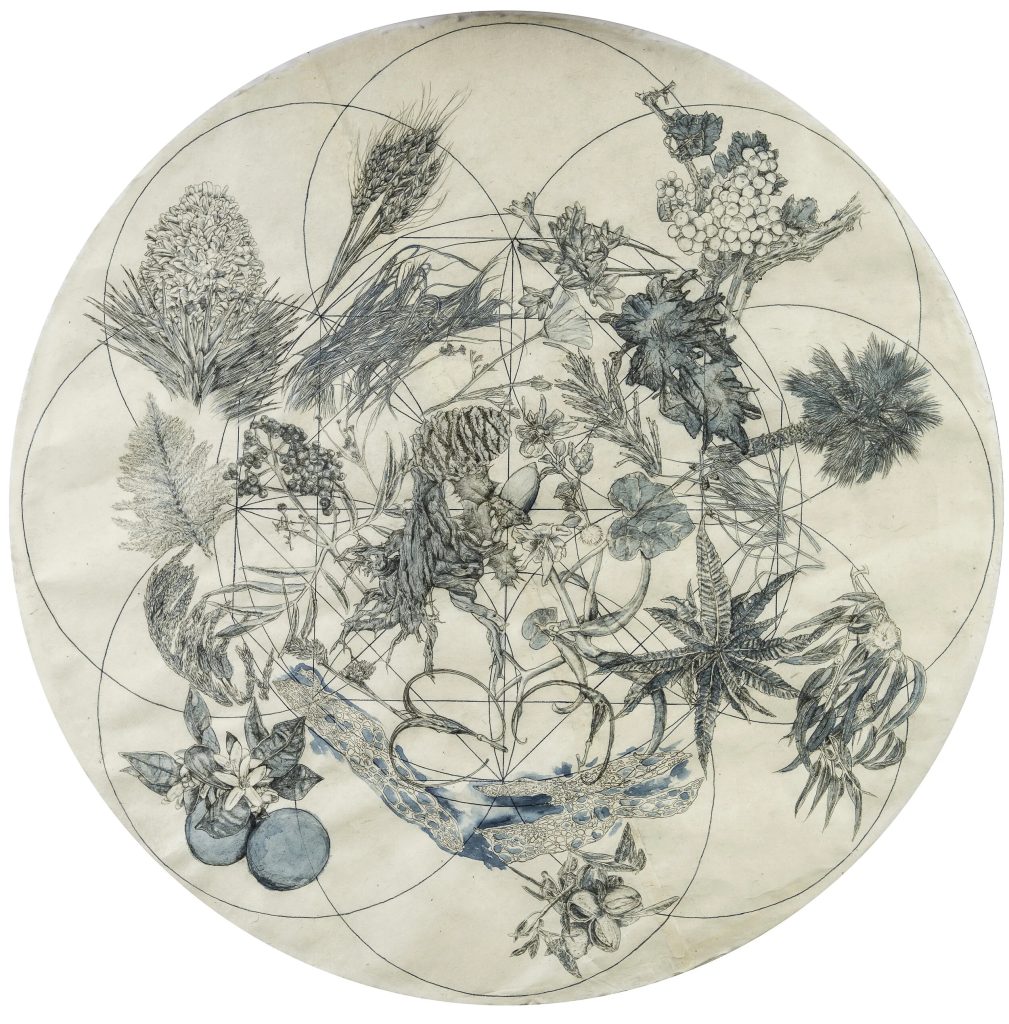
Thinking of the dismal cycles of global capitalism in the work of her teacher, photographer and theorist, Allan Sekula, Miyo’s Dismal Cycle zooms in on local plant time. As the artist describes of the work:
Dismal Cycle is a piece that illustrates the transformation of California land use by its inhabitants over time. Intended to serve as a visual timeline, the drawing starts with California’s oldest plant life in the center and spirals outward, displaying native plants tended to and utilized by various native California tribes and concluding with non-native plants introduced by European settlers, missionaries, and plants that represent the monoculture of today’s farming industry. I am interested in exploring how we in today’s society have become so disconnected with our environment, that it has become second nature to tune out the consequences of our actions. In doing research for this project I have learned a lot about the history of land use and attitudinal changes towards the environment over time. Perhaps by learning about the ways in which we have impacted our environment, we can reconnect and preserve what remains of the land for future generations.
Dismal Cycle: California Flora is dedicated to Allan Sekula.
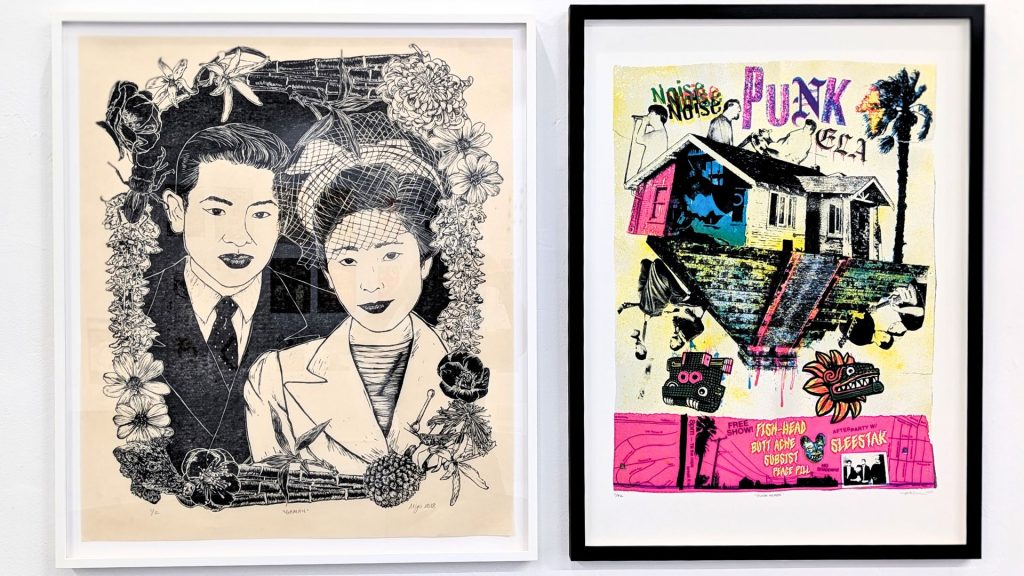
This pairing brings together two local Chicano and Japanese American punk histories.
Gaman, meaning to “endure with dignity” in Japanese, commemorates Miyo’s grandparents, Minoru and Iyo, who were imprisoned in Topaz Camp in Utah as part of the incarceration of Japanese-Americans in World War II. The barrack where people lived, according to the historical museum for the camp: “had no running water, a single light, and were heated by a coal stove.” It is a painful reminder of how quickly rights and life experiences can be stolen. The couple received a day pass from authorities to leave the camp to marry and they took a photo. Miyo based this print on that photograph. Originally from Okinawa, the newlyweds are framed with a bounty of Okinawa goods celebrating their union.
In Punk Heads Usen collaborated with musician Randy Rodarte on this tribute to East LA’s rich punk heritage. Through discussion, the musician and the artist compiled various elements of the still fresh punk poster aesthetic of the 80s and 90s. Himself a member of a punk band, Usen tapped into the variety of visual languages, from the brash colors, xerox aesthetic, maps and lettering so typical of the legendary backyard house party performances.
The depicted house was Usen’s childhood home on Keenan Street in East Los Angeles. Under the house, or rather, like the underside of a glacier, is the Temple of Kulkulcan in Chichen Itza, and below the ancient Meso-American deities of the Plumed Serpent and Tlaloc. Usen explains that it was common to refer to the “punk heads” and “goth heads” in the 80s as a form of slang. The Meso-American gods are depicted as punk heads, as well.
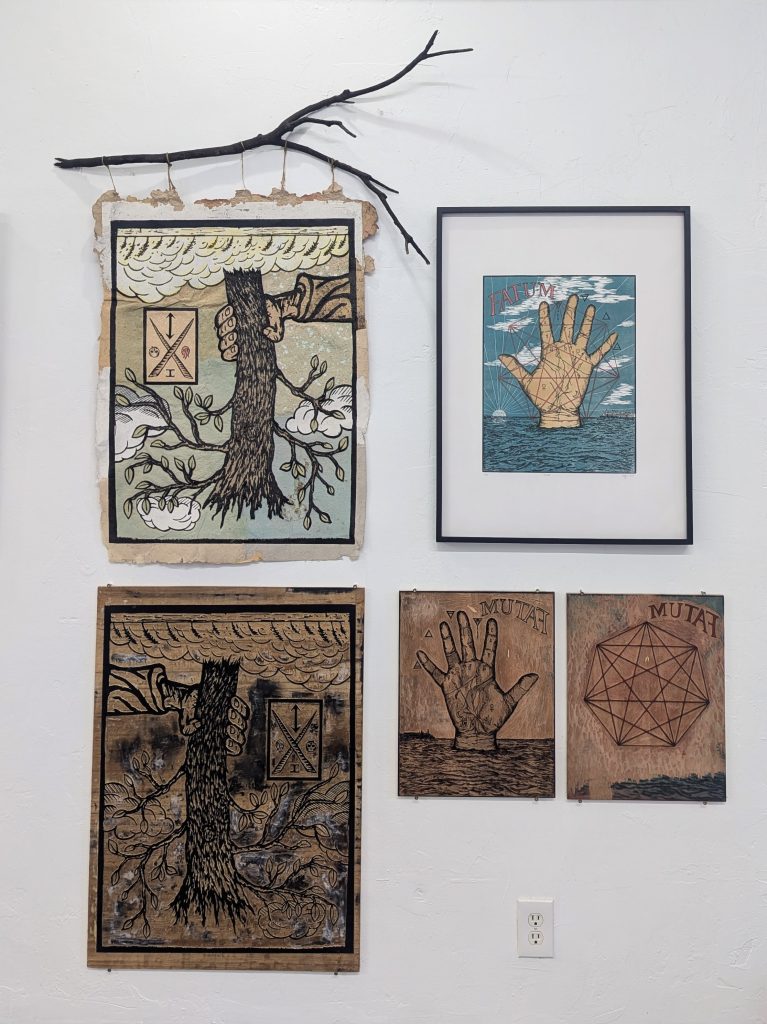
In this [above] pairing the visitor receives a reading of a palm and a tarot draw. Paired with their original wood block matrices the visitor can consider the process of making a woodblock print and the differences of process between the artists.
These prints read futures. The upside down Ace of Wands portends poorly. Made out of recycled paper and tenuously collaged together, the print hangs by a branch burnt in a local fire. In the upper quadrant of the print we see smoke in the style of Tarot and Medieval manuscripts. The wand is a hulking tree trunk pointing to man’s hand in our ecological disaster, but it is also an enormous unknown hand making everything upside-down and unrooted, common feelings in our times.
Fatum was printed with the assistance of the Taller Experimental de Gráfica printmakers in Havana, Cuba on a press dating back to the 1700’s. Miyo offers the open hand as a site of offering, mysticism and politics, as she explains:
“The word Fatum is Latin for fate or destiny and references fate or destiny regarding the future of relations between the U.S. and Cuba and also the fate of islands like Cuba in the face of climate change and rising sea levels. Ambiguous by design, it can be seen as a fortune teller’s hand drowning or rising, with the Castillo De Los Tres Reyes Del Morro in the background illuminated by a setting or rising sun.”
Popularly thought to contain one’s fate, the audience is invited to consider the range of meanings hands make manifest The hands exhibited on this wall burn, wet, greet, foretell, symbolize, hold, offer, accept, stop, bless, reach up, reach down and reach out.
Images below courtesy of Santos Nuñez and MexiCali Biennial
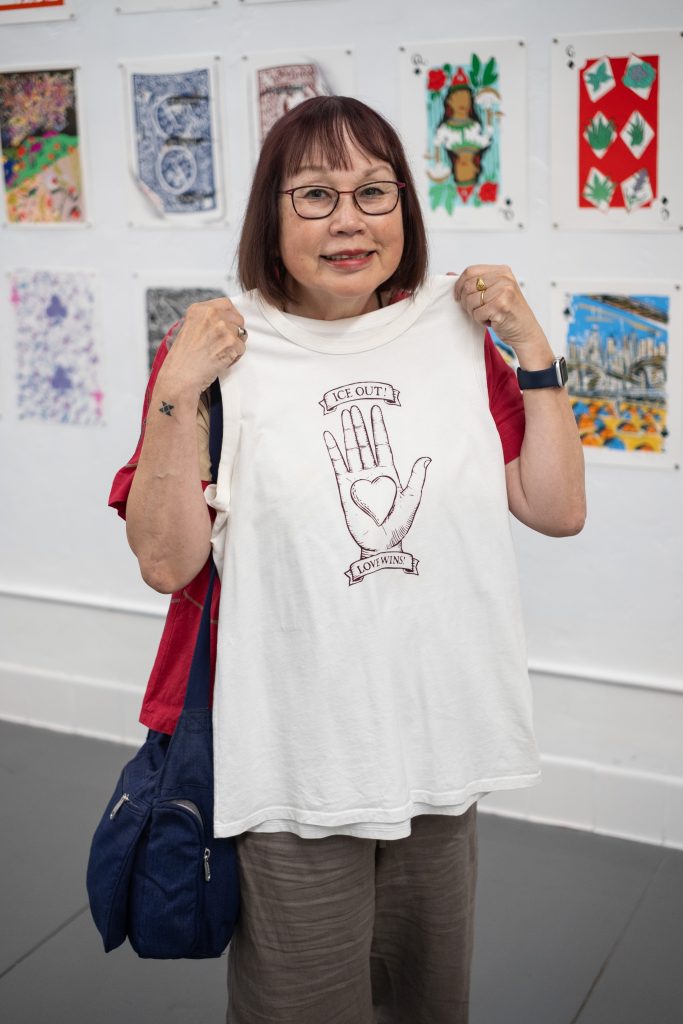
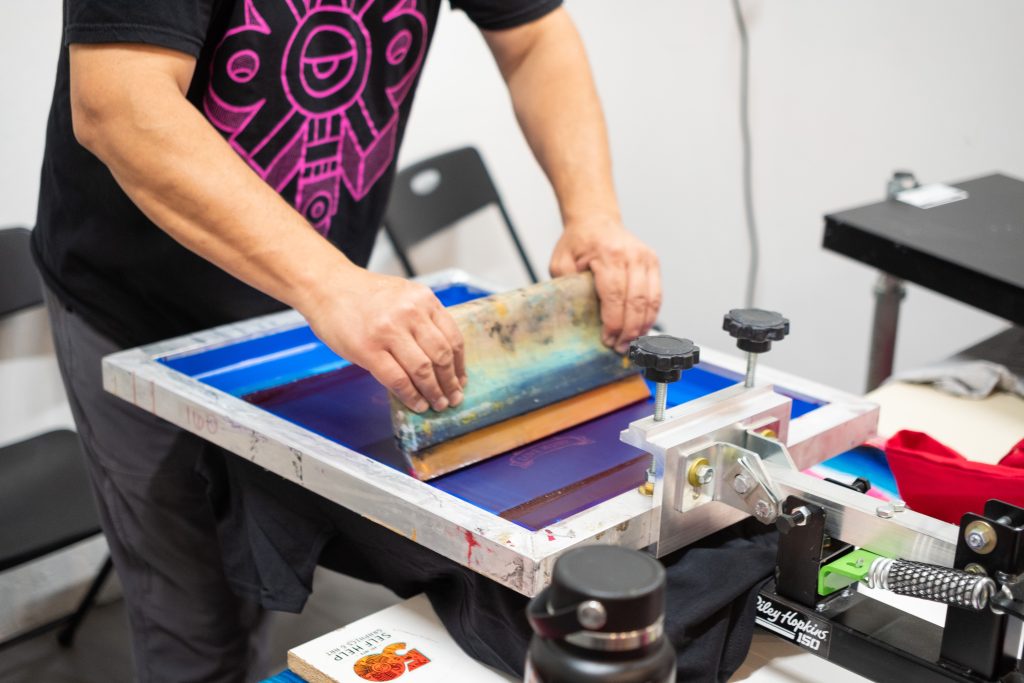
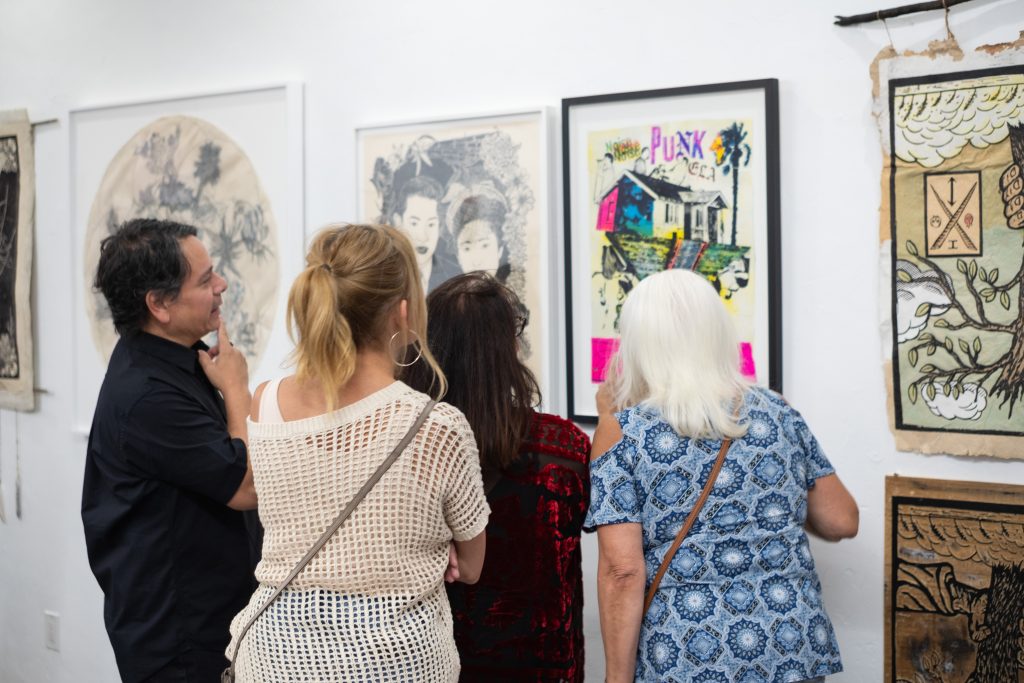
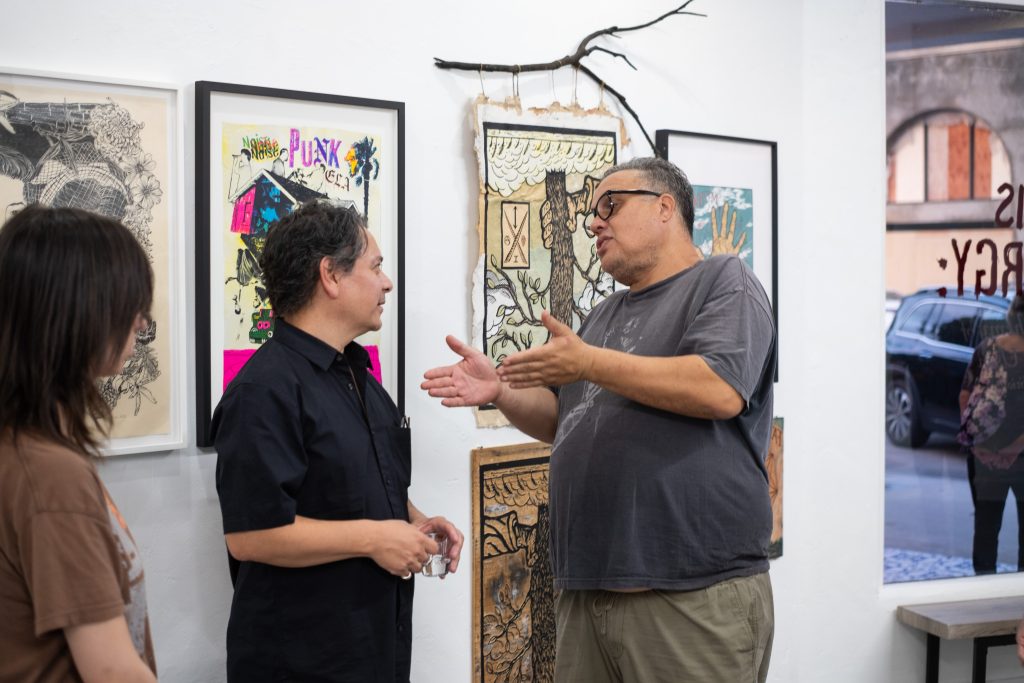
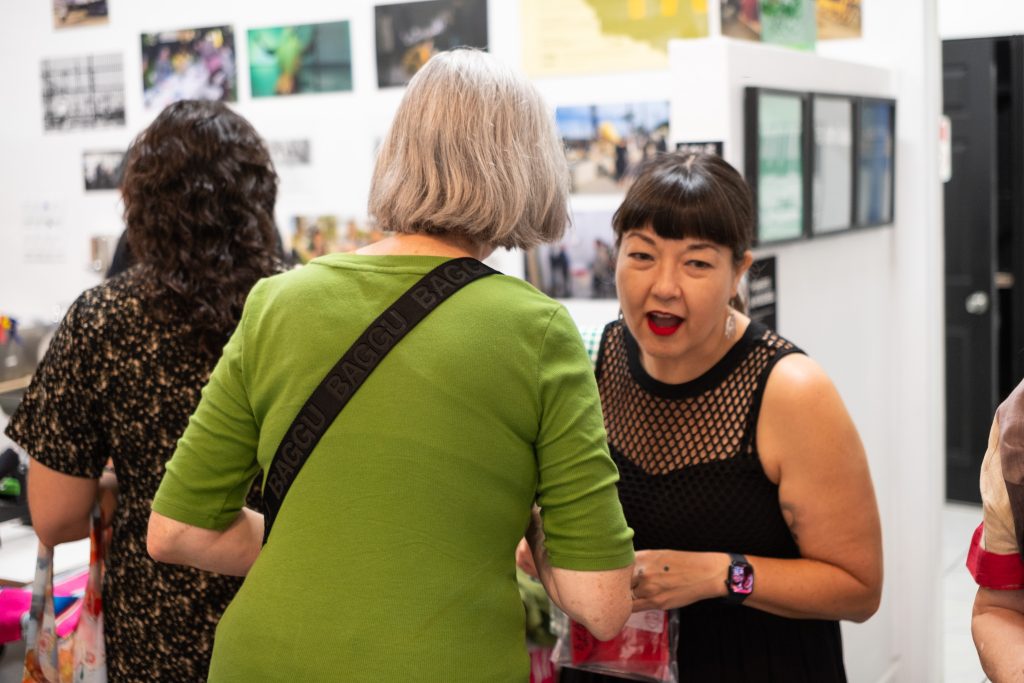
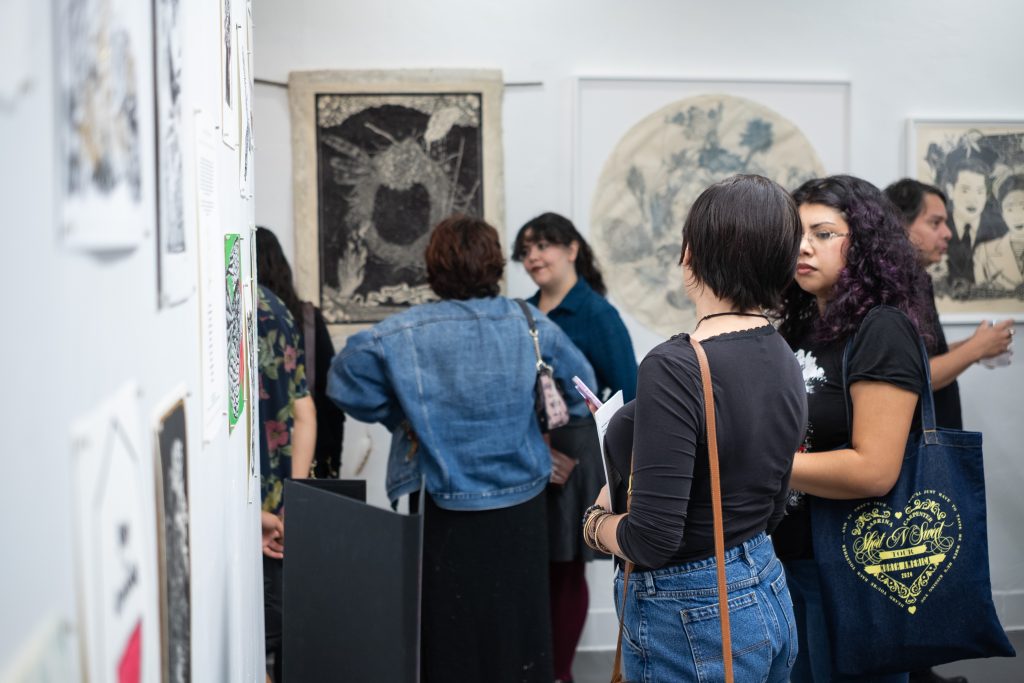
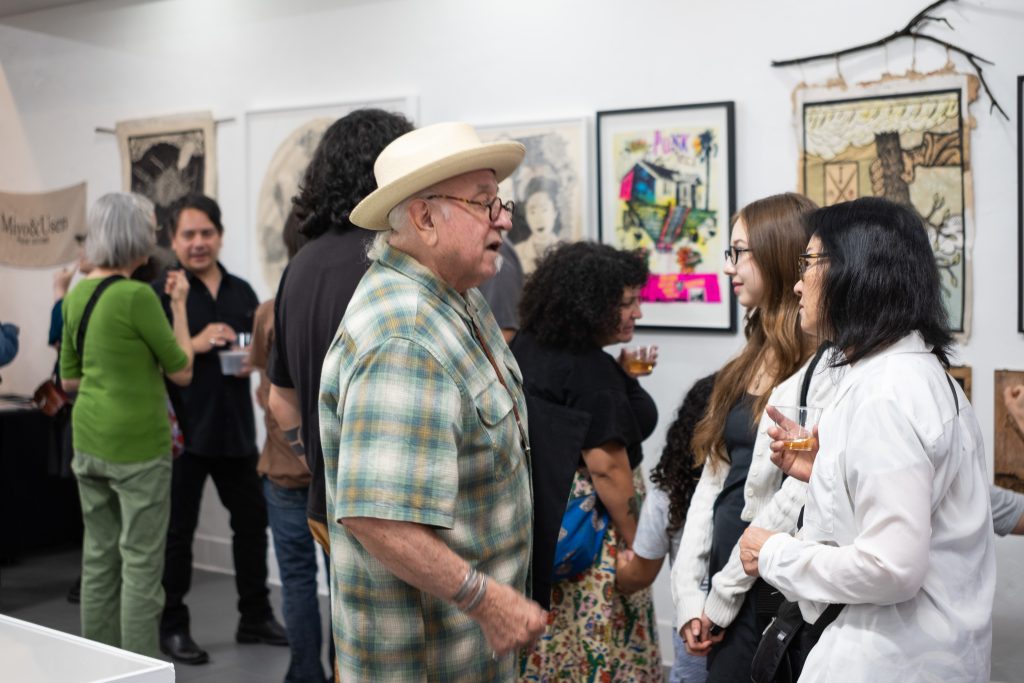
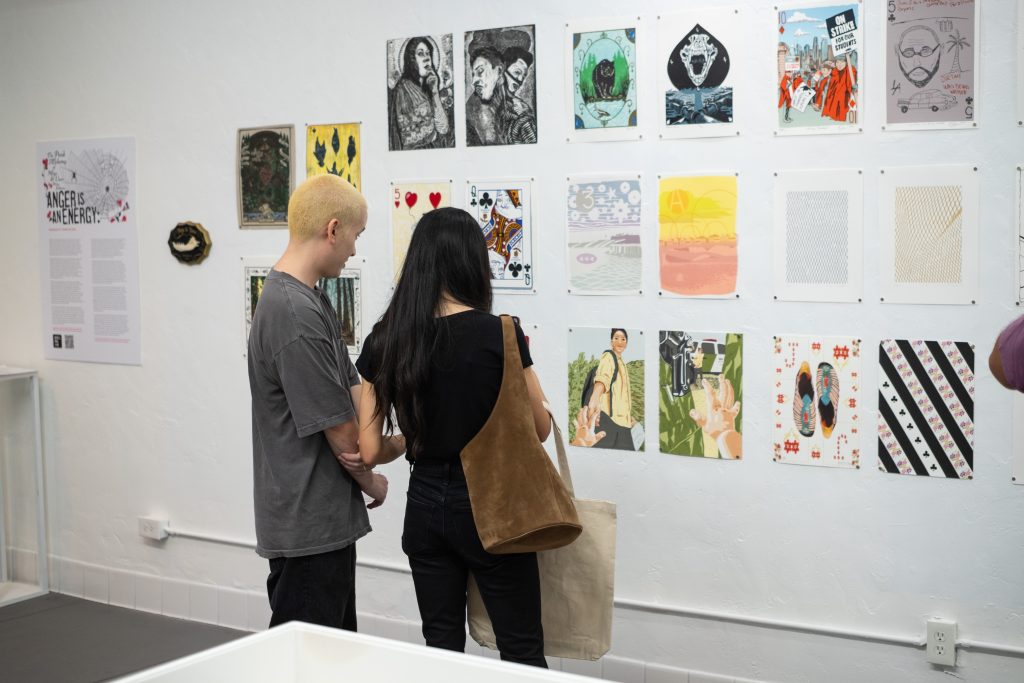
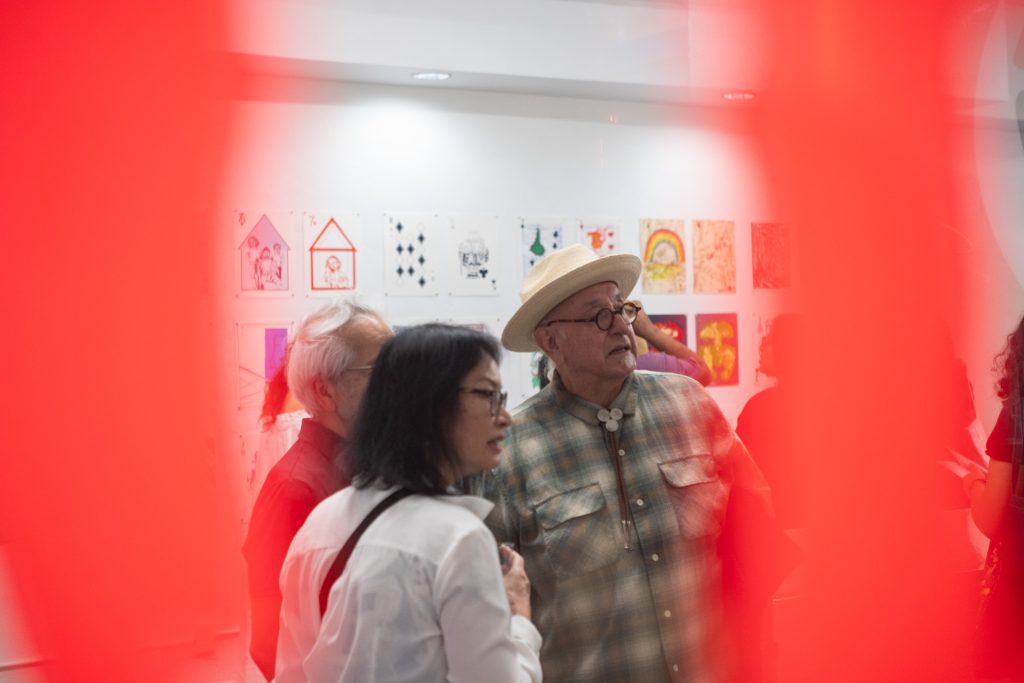
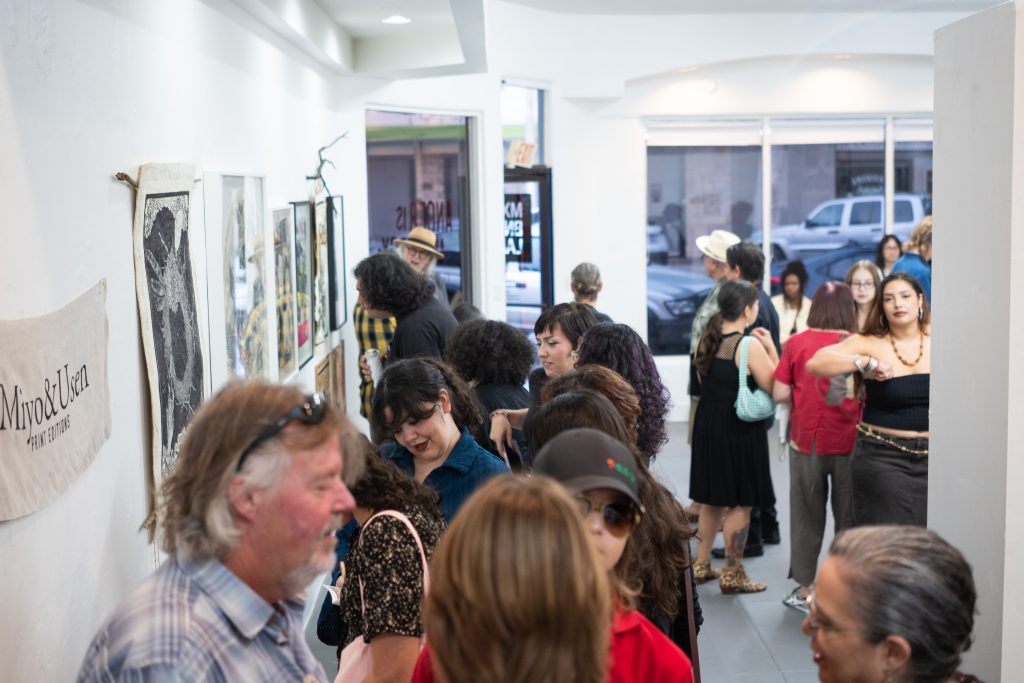
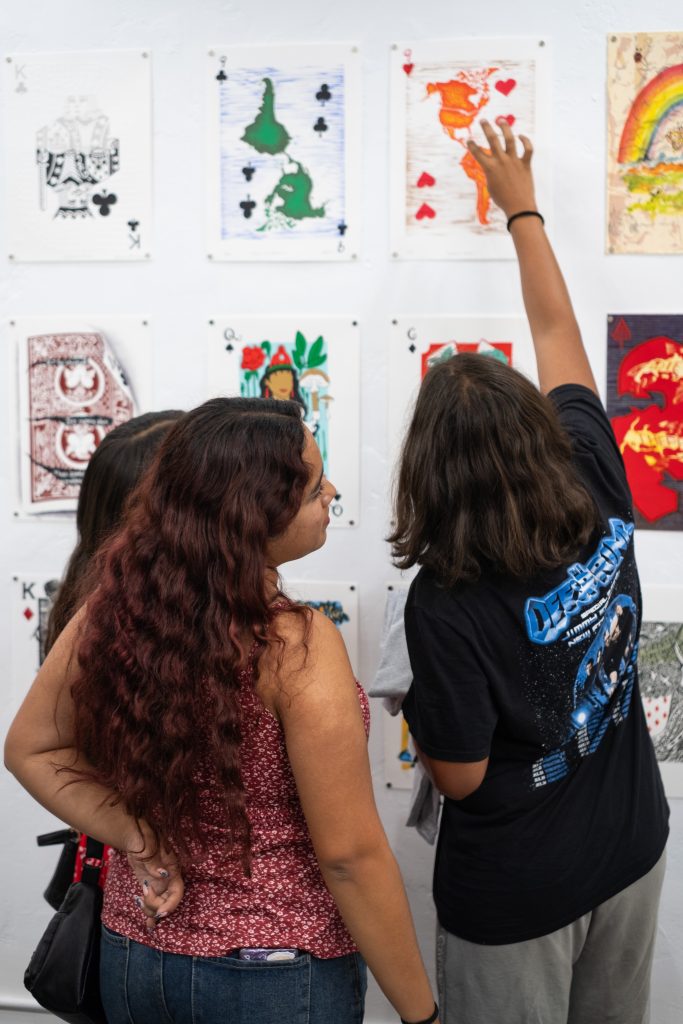
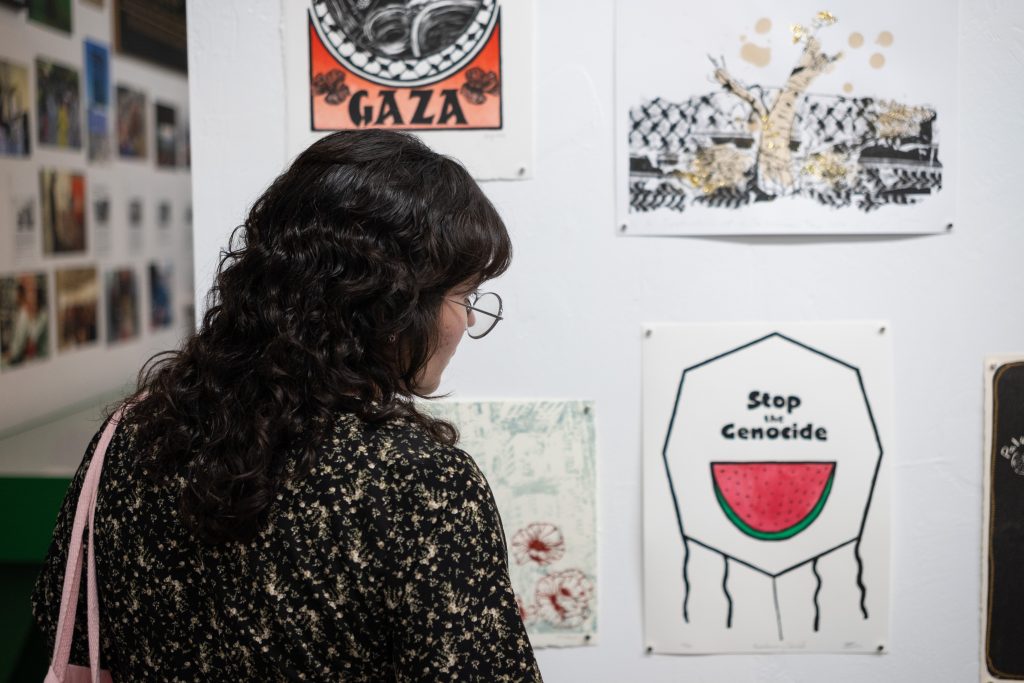
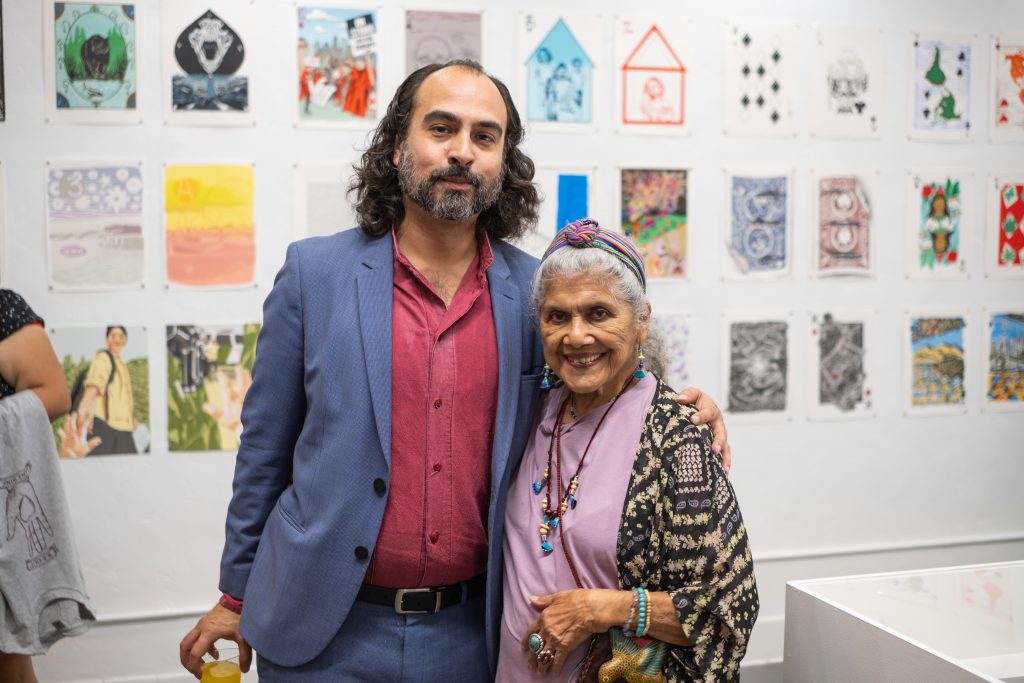















Inquiries about the works can be made directly to the artists:
Usen Gandara was raised by his mother and grandmother in East L.A. He attended public schools where he encountered cultural repression, systems of neglect, discrimination and violence. These experiences, countered by a matriarchal upbringing that nurtured his creativity, formed his art practice and taught him resilience and resourcefulness. He works in printmaking, painting and publishing. His work explores themes of isolation, loss, the complex nature of beauty and the beauty found in everyday nature. He works with classical and esoteric themes, using allegory to expand understanding of the human condition.
www.usengandara.com
IG: @miyo_usen_editions
Miyo Stevens-Gandara is a Los Angeles based artist working in a variety of media which include photography, drawing, embroidery, and various printmaking mediums. Her imagery explores issues of ancestry, migration, feminism, cultural identity, and environmental degradation.
She received her BFA from the California College of the Arts, and her MFA from the California Institute of the Arts. Miyo Stevens-Gandara has work in the collections of the Los Angeles County Museum of Art, Museum of Latin American Art (MoLAA), Riverside Art Museum, and various private collections. Her work has been exhibited in the U.S. and internationally.
Miyo has a strong commitment to her community as part of her art practice and has been involved in arts outreach programs throughout her career, and in her role as a tenured Associate Professor of Photography at Rio Hondo College.
https://www.miyofineart.com/
IG: @miyofineart / @miyo_usen_editions
